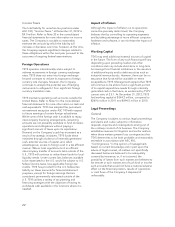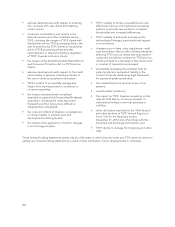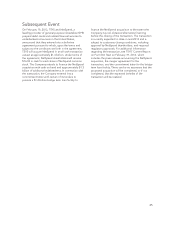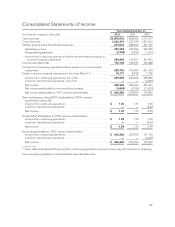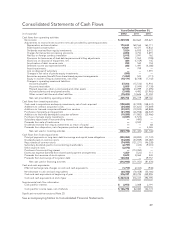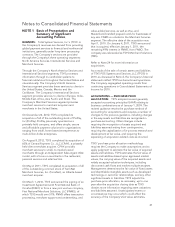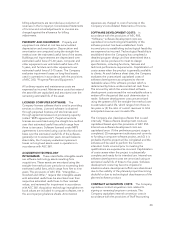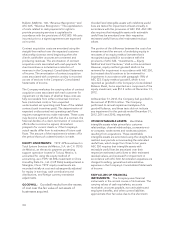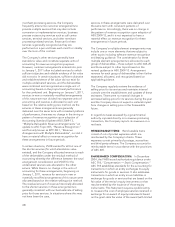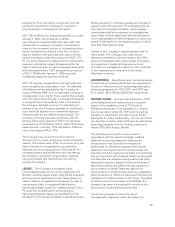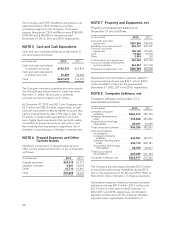NetSpend 2012 Annual Report Download - page 35
Download and view the complete annual report
Please find page 35 of the 2012 NetSpend annual report below. You can navigate through the pages in the report by either clicking on the pages listed below, or by using the keyword search tool below to find specific information within the annual report.including assumptions regarding industry economic
factors and business strategies, and result in an
impairment or a new allocation of purchase price.
Given its history of acquisitions, TSYS may allocate
part of the purchase price of future acquisitions to
contingent consideration as required by GAAP for
business combinations. The fair value calculation of
contingent consideration will involve a number of
assumptions that are subjective in nature and which
may differ significantly from actual results. TSYS may
experience volatility in its earnings to some degree in
future reporting periods as a result of these fair value
measurements.
PRINCIPLES OF CONSOLIDATION AND BASIS OF
PRESENTATION: The accompanying consolidated
financial statements include the accounts of TSYS and
its majority owned subsidiaries. All significant
intercompany accounts and transactions have been
eliminated in consolidation. In addition, the Company
evaluates its relationships with other entities to
identify whether they are variable interest entities as
defined in accordance with the provisions of
Accounting Standards Codification (ASC) 810,
“Consolidation,” and to assess whether it is the
primary beneficiary of such entities. If the
determination is made that the Company is the
primary beneficiary, then that entity is included in the
consolidated financial statements in accordance with
ASC 810.
RISKS AND UNCERTAINTIES AND USE OF
ESTIMATES: Factors that could affect the
Company’s future operating results and cause actual
results to vary materially from expectations include,
but are not limited to, lower than anticipated growth
from existing clients, an inability to attract new clients
and grow internationally, loss of a major customer or
other significant client, loss of a major supplier, an
inability to grow through acquisitions or successfully
integrate acquisitions, an inability to control
expenses, technology changes, the impact of the
application of and/or changes in accounting
principles, financial services consolidation, changes in
regulatory requirements, a decline in the use of cards
as a payment mechanism, disruption of the
Company’s international operations, breach of the
Company’s security systems, a decline in the financial
stability of the Company’s clients and uncertain
economic conditions. Negative developments in
these or other risk factors could have a material
adverse effect on the Company’s financial position,
results of operations and cash flows.
The Company has prepared the accompanying
consolidated financial statements in conformity with
accounting principles generally accepted in the
United States of America. The preparation of the
consolidated financial statements requires
management of the Company to make a number of
estimates and assumptions relating to the reported
amounts of assets and liabilities at the date of the
consolidated financial statements and the reported
amounts of revenues and expenses during the
period. These estimates and assumptions are
developed based upon all information available.
Actual results could differ from estimated amounts.
CASH EQUIVALENTS: Investments with a maturity
of three months or less when purchased are
considered to be cash equivalents.
ACCOUNTS RECEIVABLE: Accounts receivable
balances are stated net of allowances for doubtful
accounts and billing adjustments of $3.9 million and
$4.1 million at December 31, 2012 and
December 31, 2011, respectively.
TSYS records an allowance for doubtful accounts
when it is probable that the accounts receivable
balance will not be collected. When estimating the
allowance for doubtful accounts, the Company takes
into consideration such factors as its day-to-day
knowledge of the financial position of specific clients,
the industry and size of its clients, the overall
composition of its accounts receivable aging, prior
history with specific customers of accounts receivable
write-offs and prior experience of allowances in
proportion to the overall receivable balance. This
analysis includes an ongoing and continuous
communication with its largest clients and those
clients with past due balances. A financial decline of
any one of the Company’s large clients could have a
material adverse effect on collectability of receivables
and thus the adequacy of the allowance for doubtful
accounts.
Increases in the allowance for doubtful accounts are
recorded as charges to bad debt expense and are
reflected in selling, general and administrative
expenses in the Company’s Consolidated Statements
of Income. Write-offs of uncollectible accounts are
charged against the allowance for doubtful accounts.
TSYS records an allowance for billing adjustments for
actual and potential billing discrepancies. When
estimating the allowance for billing adjustments, the
Company considers its overall history of billing
adjustments, as well as its history with specific clients
and known disputes. Increases in the allowance for
32


